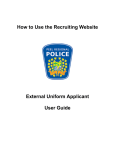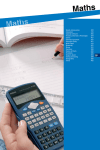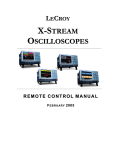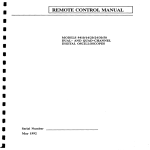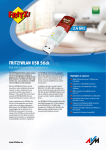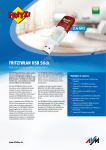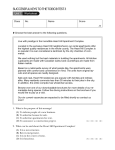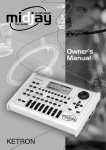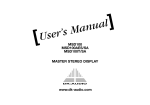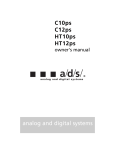Download 7980190 - Educational Alternative Outreach Program
Transcript
1999 Florida Department of Education COURSE DESCRIPTION - GRADES 9-12, ADULT SUGGESTED COURSE PERFORMANCE OBJECTIVES Subject Area: Course Number: Course Title: Credit: Vocational Education for Students with Disabilities 7980190 Technology Education Multiple Will meet graduation requirement for Practical Arts A. Major Concepts/Content. The purpose of this course is to provide students with disabilities instruction in technological literacy and a foundation of knowledge and basic skills related to technology. The content should include, but not be limited to, the following: - integrated technology studies technology systems technology applications careers in technology This course shall integrate the Sunshine State Standards and Goal 3 Student Performance Standards of the Florida System of School Improvement and Accountability as appropriate to the individual student and to the content and processes of the subject matter. Students with disabilities shall: CL.A.1.In.1 complete specified Sunshine State Standards with modifications as appropriate for the individual student. CL.A.1.Su.1 complete specified Sunshine State Standards with modifications and guidance and support as appropriate for the individual student. B. Special Note. This entire course may not be mastered in one year. A student may earn multiple credits in this course. The particular course requirements that the student should master to earn each credit must be specified on an individual basis. Multiple credits may be earned sequentially or simultaneously. This course is primarily designed for students functioning at independent and supported levels. Students functioning at independent levels are generally capable of working and living independently and may need occasional assistance. Students functioning at supported levels are generally capable of living and working with ongoing supervision and support. Three levels of functioning, independent, supported, and participatory, have been designated to provide a way to differentiate benchmarks and course requirements for students with diverse abilities. Individual students may 1279 Course Number: 7980190 - Technology Education function at one level across all areas, or at several different levels, depending on the requirements of the situation. This course may also be used to accommodate the wide range of abilities within the population of students with disabilities. The particular benchmark for a course requirement should be selected for individual students based on their levels of functioning and their desired post-school outcomes for adult living and employment specified in the Transition Individual Educational Plan. Instructional activities involving practical applications of course requirements may occur in naturalistic settings in home, school, and community for the purposes of practice, generalization, and maintenance of skills. These applications may require that the student acquire the knowledge and skills involved with the use of related technology, tools, and equipment. • For requirements/objectives mastered at the Independent Level, students are expected to be able to perform the behaviors identified for each benchmark on their own once they have mastered the knowledge and skills. • For requirements/objectives mastered at the Supported Level, mastery should be determined with consideration of the amount and type of guidance and support necessary to the student to perform the behavior. This generally consists of some type of prompting or supervision. Physical prompt—a touch, pointing, or other type of gesture as a reminder Verbal prompt—a sound, word, phrase, or sentence as a reminder Visual prompt—color coding, icons, symbols, or pictures as a reminder Assistive technology—an alarm, an electronic tool Supervision—from occasional inspection to continuous observation • For requirements/objectives mastered at the Participatory Level, mastery should be determined with consideration of the amount and type of assistance necessary to the student to participate in the performance of the behavior. Physical assistance—from a person, such as full physical manipulation or partial movement assistance Assistive technology—full: props, bolsters, pads, electric wheelchair; partial: straps, lapboards, adapted utensils The performance objectives are not intended to be exhaustive of all the possible short-term objectives a student may need in this multiple credit course. Other objectives should be added as required by an individual student. C. Instructional activities involving practical applications of course requirements may occur in naturalistic settings in home, school, and community for the purposes of practice, generalization, and maintenance of skills. These applications may require that the student acquire the knowledge and skills involved with the use of related technology, tools, and equipment. Experiences should be provided to assist the students in evaluating their interests, abilities, and needs as they relate to the world of work. The use of community resource people is encouraged. Course Requirements. These requirements include, but are not limited to, the benchmarks from the Sunshine State Standards for Special Diploma that are most 1280 Course Number: 7980190 - Technology Education relevant to this course. Benchmarks correlated with a specific course requirement may also be addressed by other course requirements as appropriate. Some requirements in this course are not fully addressed in the Sunshine State Standards for Special Diploma. After successfully completing this course, the student will: 1. Demonstrate understanding and proficiency in the use of a variety of computer applications and hardware, including networking (e.g., word processing, graphics, data management, telecommunications, desktop publishing, computer-assisted drawing, robotics). CL.C.2.In.2 use appropriate technology and tools to complete tasks in the workplace. CL.C.2.Su.2 use appropriate technology and tools to complete tasks in the workplace—with guidance and support. Indicate guidance and support necessary for mastery at supported level: ___ physical prompt ___ verbal prompt ___ visual prompt ___ assistive technology ___ supervision ___ other: ____________________ 1.1. Demonstrate proficiency in basic computer skills. (CL.C.2.In.2, CL.C.2.Su.2) Specify: _____ ❏ installing and uninstalling programs _____ ❏ using the mouse _____ ❏ moving between programs _____ ❏ using the keyboard _____ ❏ other: _______________________________________ 1.2. Use various software programs to complete functional tasks related to information management. (CL.C.2.In.2, CL.C.2.Su.2) Specify: _____ _____ _____ _____ _____ ❏ word processing software ❏ graphics and presentation software ❏ spreadsheets and databases ❏ desktop publishing software ❏ other: _______________________________________ 1.3. Select correct tools and equipment for assigned task. (Social and Personal C 24: IV) 1.4. Access available databases through the Internet to complete functional tasks. (CL.C.2.In.2, CL.C.2.Su.2) Specify: _____ ❏ use software to access the Internet _____ ❏ use search engines _____ ❏ other: _______________________________________ 1281 Course Number: 7980190 - Technology Education 1.5. Use a software application to communicate with a person at a computer at another location to complete functional tasks. (CL.C.2.In.2, CL.C.2.Su.2) Specify: _____ ❏ use e-mail _____ ❏ conferencing—two-way video, web board, telnet, on-line discussion _____ ❏ other: _______________________________________ 1.6. Use current manufacturing technology to solve a problem or produce a product (e.g., design and manufacture a game, solve a classroom problem). (CL.C.2.In.2, CL.C.2.Su.2, CL.B.4.In.2, CL.C.2.Su.2) 1.7. Use current technology to solve a problem or produce a product related to transportation (e.g., design a prototype vehicle that will transport a payload under simulated aquatic, land, or air conditions). (CL.C.2.In.2, CL.C.2.Su.2, CL.B.4.In.2, CL.B.4.Su.2) 1.8. Identify problems related to biotechnology using appropriate resources (e.g., using hydroponics to grow vegetables, investigating the feasibility of using aquaculture to raise oysters, using biotechnology to solve problems related to environmental pollution, using biotechnology to solve problems related to the human body). (CL.C.2.In.2, CL.C.2.Su.2, CL.B.4.In.2, CL.C.2.Su.2) 1.9. Use current technology to solve a problem or produce a product involving biotechnology (e.g., design and produce an assistive device, design and construct a system to grow plants without soil, design and develop a recycling system, design and construct a productive habitat). (CL.C.2.In.2, CL.C.2.Su.2, CL.B.4.In.1, CL.B.4.Su.2) 2. Demonstrate knowledge and skills needed to care for hardware and obtain assistance when problems occur. Indicate guidance and support necessary for mastery at supported level: ___ physical prompt ___ verbal prompt ___ visual prompt ___ assistive technology ___ supervision ___ other: ____________________ 2.1. Identify items of hardware that require care (e.g., computers, safety equipment, production equipment). (CL.C.2.In.2, CL.C.2.Su.2) 2.2. Identify type of care required for specified hardware (e.g., cleaning, maintenance, handling or moving, storage). (CL.C.2.In.2, CL.C.2.Su.2) 2.3. Demonstrate knowledge and skills needed to care for each specific type of hardware (e.g., climate control, dusting, glass cleaning, static removal, battery or power check, pressure check). Specify: _____ ❏ computer _____ ❏ CPU _____ ❏ keyboard _____ ❏ printer _____ ❏ monitor _____ ❏ mouse _____ ❏ smoke detector _____ ❏ fire extinguisher _____ ❏ remote control _____ ❏ other: _______________________________________ 1282 Course Number: 7980190 - Technology Education 2.4. Use proper care and maintenance of tools and materials. (Social and Personal C 29: V) 2.5. Use safety equipment and procedures when necessary. (Social and Personal C 32: VI) 2.6. Demonstrate strategies to care for hardware on a regular basis (e.g., set up a regular cleaning and maintenance schedule, keep number of technical support in a convenient place). (CL.C.2.In.2, CL.C.2.Su.2) 2.7. Recognize possible problems with hardware (e.g., won’t start, blank screen). (CL.C.2.In.2, CL.C.2.Su.2) 2.8. Recognize service problems that may require technical assistance (e.g., error message appears on screen, drive makes a grinding noise). (CL.C.2.In.2, CL.C.2.Su.2) 2.9. Seek help and accept assistance. (Social and Personal C 21: III) 2.10. Identify sources of assistance for solving problems with hardware and software (e.g., on-line help resources, manuals, on-site technician, outside repair company). (CL.C.2.In.2, CL.C.2.Su.2) 2.11. Identify items of software that require care (e.g., floppy disks, compact disks). (CL.C.2.In.2, CL.C.2.Su.2) 2.12. Identify type of care required for each type of software (e.g., cleaning, storage, handling). (CL.C.2.In.2, CL.C.2.Su.2) 2.13. Demonstrate knowledge and skills needed to care for type of software (disks—do not store near magnet; CD—clean after handling). (CL.C.2.In.2, CL.C.2.Su.2) Specify: _____ ❏ floppy disks _____ ❏ CD _____ ❏ other: ______________________________________ 2.14. Demonstrate strategies to care for software on a regular basis (e.g., post a list of do’s and don'ts, keep user's manual nearby, ask a knowledgeable user). (CL.C.2.In.2, CL.C.2.Su.2) 2.15. Recognize possible problems with software (e.g., programs stop working, unexpected data appear). (CL.C.2.In.2, CL.C.2.Su.2) 2.16. Recognize problems with software that may require technical assistance (e.g., disk will not open as it usually does, file disappears from disk, equipment does not function properly). (CL.C.2.In.2, CL.C.2.Su.2) 2.17. Identify sources of assistance for software problems (e.g., on-line help resources, manual, on-site technician, outside repair company). (CL.C.2.In.2, CL.C.2.Su.2) 1283 Course Number: 7980190 - Technology Education 3. Recognize and appropriately use cognitive strategies and problem solving skills when using technology. CL.B.4.In.1 identify problems and examine alternative solutions. CL.B.4.In.2 implement solutions to problems and evaluate effectiveness. CL.B.4.Su.1 identify problems found in functional tasks—with guidance and support. CL.B.4.Su.2 implement solutions to problems found in functional tasks—with guidance and support. Indicate guidance and support necessary for mastery at supported level: ___ physical prompt ___ verbal prompt ___ visual prompt ___ assistive technology ___ supervision ___ other: ___________________ 3.1. Identify that a problem exists when using technology (there is a discrepancy between what is and what should or could be). (CL.B.4.In.1, CL.B.4.Su.1) 3.2. Identify possible reasons for existing problems in using technology (e.g., did not understand what is expected, did not stay on task, did not have appropriate software, was not given enough time). (CL.B.4.In.1, CL.B.4.Su.1) 3.3. Analyze possible outcomes associated with specific problems using technology (e.g., work does not get done, work is not done well, work is not completed on time). (CL.B.4.In.1, CL.B.4.Su.1) 3.4. Apply a general model for solving real-world problems when using technology (e.g., identify the problem, identify alternatives, evaluate alternative solutions, choose appropriately from a variety of techniques, implement solution, evaluate results). (CL.B.4.In.1, CL.B.4.Su.1) 3.5. Identify mistakes on task assignments with and without assistance. (Social and Personal C 28: V) 3.6. Identify characteristics of basic problem-solving strategies. (CL.B.4.In.1, CL.B.4.Su.1) 3.7. Select the most appropriate alternative or strategy for solving a specified problem. (CL.B.4.In.1, CL.B.4.Su.1) Specify: _____ ❏ brainstorming—identifying all solutions that come to mind _____ ❏ estimate—when numbers are involved _____ ❏ matching consequences to actions—for cause and effect _____ ❏ troubleshooting—finding problems within a work process _____ ❏ creative thinking—identifying multiple or unusual solutions _____ ❏ modeling—basing actions on those of a good example _____ ❏ other: ______________________________________ 3.8. Apply brainstorming techniques when starting to solve a problem when using technology (e.g., identify problem, identify every solution that comes to mind, evaluate all solutions). (CL.B.4.In.1, CL.B.4.Su.1) 1284 Course Number: 7980190 - Technology Education 3.9. Estimate answers to problems involving numbers before solving them (e.g., estimate amount of time needed to complete a task when pressed for time; estimate the number of backup copies of disks to make). (CL.B.4.In.1, CL.B.4.Su.1) 3.10. Predict consequences to actions when solving problems involving use of technology (e.g., files may not translate, disk may become full, may save file as a backup). (CL.B.4.In.1, CL.B.4.Su.1) 3.11. Identify the steps of a complicated process when solving a technology problem involving many tasks. (CL.B.4.In.1, CL.B.4.Su.1) 3.12. Use troubleshooting for problems using technology when the cause is not easily seen (e.g., use utilities software to diagnose problem). (CL.B.4.In.1, CL.B.4.Su.1) 3.13. Apply creative-thinking strategies when using technology to solve problems in which a variety of solutions are possible (e.g., designing a brochure or pamphlet, re-arrange desktop for greater productivity). (CL.B.4.In.1, CL.B.4.Su.1) 3.14. Apply modeling techniques when using technology to solve problems for which a good example exists (e.g., use wizards in software programs). (CL.B.4.In.1, CL.B.4.Su.1) 3.15. Analyze consequences of each alternative course of action for solving a particular problem using technology (e.g., use of diagnostic software may find the problem but may also take a lot of time). (CL.B.4.In.1, CL.B.4.Su.1) 3.16. Use appropriate techniques or tools to solve problems when using technology (e.g., make a checklist of work to be accomplished, set up an electronic scheduler). (CL.B.4.In.2, CL.B.4.Su.2) 3.17. Seek assistance when needed to solve problems when using technology (e.g., difficulty completing work task—consult supervisor, co-workers, references). (CL.B.4.In.2, CL.B.4.Su.2) 3.18. Describe effectiveness of problem-solving strategies (e.g., How well did this approach work? Was the problem eliminated? Did this process negatively impact anyone else?). (CL.B.4.In.2, CL.B.4.Su.2) 3.19. Determine impact of decisions and activities related to solving the problem (e.g., determine if solution solved problem, increased the problem, caused new problems). (CL.B.4.In.2, CL.B.4.Su.2) 1285 Course Number: 7980190 - Technology Education 4. Display appropriate communication, interpersonal, and leadership skills. SE.A.1.In.1 cooperate in a variety of group situations. SE.A.1.In.2 assist in establishing and meeting group goals. SE.A.1.In.3 function effectively within formal organizations. SE.A.1.Su.1 cooperate in group situations—with guidance and support. SE.A.1.Su.2 function effectively within formal organizations—with guidance and support. SE.A.2.In.1 interact acceptably with others within the course of social, vocational, and community living. SE.A.2.Su.1 interact acceptably with others within the course of social, vocational, and community living—with guidance and support. CO.A.1.In.1 initiate communication and respond effectively in a variety of situations. CO.A.1.Su.1 initiate communication and respond effectively in a variety of situations—with guidance and support. Indicate guidance and support necessary for mastery at supported level: ___ physical prompt ___ verbal prompt ___ visual prompt ___ assistive technology ___ supervision ___ other: ____________________ Communication Skills 4.1. Use appropriate nonverbal language and gestures when communicating in work situations. (CO.A.1.In.1, CO.A.1.Su.1) Specify: _____ ❏ facial expressions _____ ❏ gestures _____ ❏ hand signals _____ ❏ sounds _____ ❏ body language _____ ❏ other: ______________________ 4.2. Use appropriate vocabulary, grammar, and sentence structure to communicate messages clearly, precisely, and effectively when sharing ideas, opinions, and information in work situations. (CO.A.1.In.1, CO.A.1.Su.1) 4.3. State steps to complete a task. (Language C 31: VI) 4.4. Use appropriate social language skills in work situations. (CO.A.1.In.1, CO.A.1.Su.1) Specify: _____ _____ _____ _____ _____ _____ _____ ❏ initiating topics ❏ maintaining topics ❏ taking turns ❏ ending a conversation ❏ repairing communication breakdowns ❏ showing sensitivity to cultural differences ❏ other: ______________________________________ 4.5. Use language to initiate social greeting. (Language C 23: III) 4.6. Use appropriate language to express need for assistance in work situations (e.g., ask for help, raise hand, call person’s name, press a buzzer). (CO.A.1.In.1, CO.A.1.Su.1) 1286 Course Number: 7980190 - Technology Education 4.7. Ask questions to obtain information and expand knowledge. (Language C 27: IV) 4.8. Use critical listening skills to gain understanding in work situations. (CO.A.1.In.1, CO.A.1.Su.1) Specify: _____ _____ _____ _____ _____ 4.9. ❏ listening for content ❏ paying attention to cues—first, second...; in summary; most important ❏ linking to prior knowledge and experiences ❏ considering emotional meaning ❏ other: _____________________________________ Use strategies to improve listening in work situations (e.g., empathize with and “read” people, check for understanding, nod or comment in response to communication, be sensitive to the environment, request feedback on own listening patterns). (CO.A.1.In.1, CO.A.1.Su.1) 4.10. Use appropriate topics and responses when engaging in conversations in work situations (e.g., familiar persons—about shared interests, common experiences; unfamiliar persons—about the weather, sports, jobs, current events). (CO.A.1.In.1, CO.A.1.Su.1) 4.11. Use language to participate appropriately in conversation. (Language C 29: V) 4.12. Use language to initiate conversation. (Language C 30: VI) 4.13. Use language to relate recent personal experiences. (Language C 26: IV) 4.14. Respond effectively to feedback given in work situations (e.g., repeat or paraphrase, ask for clarification, accept in a friendly manner, do not act defensive, explain your reasoning, thank the person for the input). (CO.A.1.In.1, CO.A.1.Su.1) 4.15. Use feedback to make changes in work situations (e.g., correct a work problem, use a different technique on a job, complete a task accurately). (CO.A.1.In.1, CO.A.1.Su.1) 4.16. Give effective feedback to others in work situations (e.g., “You need to copy files more efficiently.” “You did well on your task.” “Keep up the good work.”). (CO.A.1.In.1, CO.A.1.Su.1) 4.17. Respond appropriately to actions and expressions of emotions of others in work situations (e.g., using “I” statements, making apologies, acknowledging a discrepancy between actions and statements, asking if you can help, ignoring or leaving the person alone). (CO.A.1.In.1, CO.A.1.Su.1) 4.18. Respond appropriately to environmental and social cues to change behavior in work situations (e.g., get ready to go home, clean up workstation). (CO.A.1.In.1, CO.A.1.Su.1) 1287 Course Number: 7980190 - Technology Education 4.19. Respond appropriately to basic questions, directions, and informational statements in work situations (e.g., ask for more information related to the topic being discussed, answer a question correctly and briefly, comment by giving information that you know about the subject being discussed). (CO.A.1.In.1, CO.A.1.Su.1) 4.20. Identify appropriate responses to praise and constructive criticism. (Social and Personal G 57: V) Interpersonal Skills 4.21. Demonstrate behaviors that contribute positively to group effort in work situations (e.g., being prompt, staying on task, limiting comments to assigned topics, complimenting contributions of others, taking turns, sharing materials, being willing to make changes if needed, helping others if needed, using self-control and restraint when disagreeing, speaking up in groups and offering opinions, following the rules, resolving conflicts, handling peer pressure). (SE.A.1.In.1, SE.A.1.Su.1) 4.22. Use appropriate interpersonal communication skills when working in a group in work situations (e.g., checking for understanding, expressing opinions, stating beliefs, providing input, speaking while no one else is speaking, accepting criticism, providing feedback). (SE.A.1.In.1, SE.A.1.Su.1) 4.23. Differentiate appropriate styles of communication in formal and informal conversations. (Language B 15: V) 4.24. Demonstrate behaviors that meet social expectations when working in a group in work situations (e.g., waiting for turn, assisting others, understanding rules, abiding by rules, respecting the rights of others, being polite). (SE.A.1.In.1, SE.A.1.Su.1) 4.25. Demonstrate behaviors that meet the responsibilities of the role taken by the individual in the group in work situations (e.g., leader, recorder, timekeeper, manager, worker). (SE.A.1.In.1, SE.A.1.Su.1) 4.26. Identify behaviors which indicate the acceptance of responsibility for own actions, attitudes, and decisions. (Social and Personal G 56: V) 4.27. Cooperate with peers. (Social and Personal G 51: III) 4.28. Share plans with others in a group in work situations (e.g., explain a plan orally to others, hand out a written plan to others, develop an oral presentation to share a plan with others). (SE.A.1.In.2, SE.A.1.Su.1) 4.29. Demonstrate behaviors and communications that are complimentary to others in work situations (e.g., honoring others with awards, commending others, praising to others, applauding others, approving of others). (SE.A.2.In.1, SE.A.2.Su.1) 1288 Course Number: 7980190 - Technology Education 4.30. Recognize and display sensitivity to others' feelings in work situations (e.g., waiting until upset person is ready to talk, showing concern for upset person, letting person know you are there to talk to, showing joy for a happy person, helping a person in distress). (SE.A.2.Su.1, SE.A.2.In.1) 4.31. Identify personal feelings. (Social and Personal G 54: IV) 4.32. Demonstrate respect for others’ rights and property in work situations (e.g., do not touch others’ personal belongings, do not trespass on others’ property, do not damage others’ property, respect others’ privacy). (SE.A.2.In.1, SE.A.2.Su.1) 4.33. Show respect for property of others. (Social and Personal G 52: III) 4.34. Demonstrate use of strategies to resolve interpersonal difficulties. (Social and Personal G 60: VI) 4.35. Offer assistance to co-workers (e.g., open a door for another, help carry a box, volunteer to assist in a task). (SE.A.2.In.1, SE.A.2.Su.1) 4.36. Demonstrate behaviors that represent appropriate physical contact from others in work situations (e.g., casual greetings—shaking hands; displays of friendship—patting on back, giving a hug). (SE.A.2.In.1, SE.A.2.Su.1) 4.37. Use effective responses to inappropriate physical contact from others that will protect oneself in work situations (e.g., asking person to stop, walking away from person, backing away from person, asking for assistance from others). (SE.A.2.In.1, SE.A.2.Su.1) 4.38. Ask for assistance if one experiences inappropriate physical contact from others in work situations (e.g., calling for a co-worker’s help, asking for a supervisor’s assistance, calling a security officer for help). (SE.A.2.In.1, SE.A.2.Su.1) 4.39. Demonstrate behaviors that meet the expectations of the target business organization within the technology field (e.g., follows company policies, interacts with supervisors and coworkers appropriately, files reports as necessary). (SE.A.1.In.3, SE.A.1.Su.2) 4.40. Demonstrate behaviors that comply with the existing rules and codes of conduct of the target business organization within the technology field (e.g., making comments that reflect a positive attitude; respecting authority and co-workers; refraining from physical conflict; keeping personal problems separate from organization; being polite to others by waiting in line; helping others; not causing physical harm to others; meeting deadlines; complying with dress codes; not using tobacco, alcohol, and other drugs in the organization). (SE.A.1.In.3, SE.A.1.Su.2) Leadership Skills 4.41. Establish reasonable group goals related to completion of a task in work situations (e.g., set deadline for completion of a product, assign roles to different members of a group). (SE.A.1.In.2) 1289 Course Number: 7980190 - Technology Education 4.42. Allocate and schedule the time and space needed to accomplish group goals in work situations (e.g., schedule group meetings so every member can attend, schedule meetings in a space large enough for the group, schedule meetings in a quiet place so discussion can take place between group members). (SE.A.1.In.2) 4.43. Demonstrate steps for problem solving in work situations involving groups (e.g., discuss the problem, individually list possible causes, record individual group member’s suggestions and clarifications, discuss and determine most probable cause, implement corrective action or solution, report results, move on to the next most probable cause if initial action is ineffective). (SE.A.1.In.1, SE.A.1.Su.1) 4.44. Demonstrate leadership skills that maintain group effort in work situations (e.g., encouraging open communication lines, using negotiation and conflict resolution skills when needed). (SE.A.1.In.2) 4.45. Demonstrate leadership skills that keep the group on-task in work situations (e.g., setting goals and objectives, making standards of behavior and performance known to all, exchanging information, sharing the plan for action). (SE.A.1.In.2) 4.46. Apply leadership skills in a group activity in work situations (e.g., leading a group in discussion, acting as the spokesperson, initiating discussion within a group, controlling the flow of information in a group, developing strategies to solve a problem, motivating the action of group members). (SE.A.1.In.2) 4.47. Identify the opportunities for leadership development available through an appropriate student and/or professional organization. (SE.A.1.In.2) 5. Apply basic skills in communications, mathematics, and science appropriate to technological content and learning activities. CL.B.1.In.1 identify and locate oral, print, or visual information for specified purposes. CL.B.1.In.2 interpret and use oral, print, or visual information for specified purposes. CL.B.1.In.3 organize and retrieve oral, print, or visual information for specified purposes. CL.B.1.Su.1 identify and locate oral, print, or visual information to accomplish functional tasks—with guidance and support. CL.B.1.Su.2 interpret and use oral, print, or visual information to accomplish functional tasks—with guidance and support. CL.B.2.In.1 prepare oral, written, or visual information for expression or presentation. CL.B.2.In.2 express oral, written, or visual information for specified purposes. CL.B.2.Su.1 prepare oral, written, or visual information for expression—with guidance and support. CL.B.2.Su.2 express oral, written, or visual information to accomplish functional tasks— with guidance and support. 1290 Course Number: 7980190 - Technology Education CL.B.3.In.1 identify mathematical concepts and processes to solve problems. CL.B.3.In.2 apply mathematical concepts and processes to solve problems. CL.B.3.Su.1 identify mathematical concepts and processes needed to accomplish functional tasks—with guidance and support. CL.B.3.Su.2 apply mathematical concepts and processes needed to accomplish functional tasks—with guidance and support. CL.B.4.In.1 identify problems and examine alternative solutions. CL.B.4.In.2 implement solutions to problems and evaluate effectiveness. CL.B.4.Su.1 identify problems found in functional tasks—with guidance and support. CL.B.4.Su.2 implement solutions to problems found in functional tasks—with guidance and support. Indicate guidance and support necessary for mastery at supported level: ___ physical prompt ___ verbal prompt ___ visual prompt ___ assistive technology ___ supervision ___ other: ___________________ 5.1. Use various forms of technology to locate information (e.g., use table of contents or indexes, use search engines). (CL.B.1.In.1, CL.B.1.Su.1) Specify: _____ ❏ print materials—books, magazines, newspapers _____ ❏ electronic databases—CDs, floppy disks _____ ❏ Internet resources 5.2. Analyze and evaluate the reliability and accuracy of information obtained through various forms of technology. (CL.B.1.In.2, CL.B.1.Su.2) Specify: _____ ❏ print materials—books, magazines, newspapers _____ ❏ electronic databases—CDs, floppy disks _____ ❏ Internet resources 5.3. Organize and summarize information obtained through various forms of technology. (CL.B.1.In.3) Specify: _____ ❏ print materials—books, magazines, newspapers _____ ❏ electronic databases—CDs, floppy disks _____ ❏ Internet resources 5.4. Use correct spelling for technical terms and abbreviations (e.g., abbreviations—kb, IBM, CNN, WFSU; technical terms—RAM, CD, e-mail). (CL.B.2.In.1, CL.B.2.Su.1) 1291 Course Number: 7980190 - Technology Education 5.5. Use appropriate resources to aid in editing when using technology (e.g., writing a business or personal letter, writing a report, completing homework or class assignments, writing an e-mail message). (CL.B.2.In.1, CL.B.2.Su.1) Specify: _____ ❏ spelling dictionary _____ ❏ grammar handbook _____ ❏ specialized electronic aids _____ ❏ spelling and grammar check utility in software program _____ ❏ specialized electronic aids _____ ❏ other: _______________________________________ 5.6. Use appropriate software to create documents or presentations related to work projects. (CL.B.2.In.2, CL.B.2.Su.2) 5.7. Give directions to another person to accomplish a task using technology. (CL.B.2.In.2, CL.B.2.Su.2) Specify: _____ ❏ personal task—how to use the cardmaker application _____ ❏ school task—how to look up a reference, how to register for classes _____ ❏ work task—how to use spell check, how to fill out an on-line form 5.8. Use various forms of technology to identify the meaning of mathematical concepts and processes used in accomplishing functional tasks. (CL.B.3.In.1, CL.B.3.Su.1) Specify: _____ ❏ print materials—books, magazines, newspapers _____ ❏ electronic databases—CDs, floppy disks _____ ❏ Internet resources 5.9. Follow a systematic approach when using mathematical concepts and processes to solve problems in accomplishing functional tasks related to technology. (CL.B.3.In.2, CL.B.3.Su.2) Specify: _____ _____ _____ _____ _____ _____ 5.10. ❏ determine nature of the problem ❏ select correct technique ❏ make reasonable estimate of results ❏ apply operation or procedures to obtain results ❏ check results for accuracy and reliability ❏ explain results Use technology to solve problems involving mathematical calculations to accomplish functional tasks (e.g., calculating final grade using test scores, calculating the cost of power for running a TV for a day, calculating the average amount of sales per day). (CL.B.3.In.2, CL.B.3.Su.2) 5.11. Use technology to solve problems using organized numerical data to accomplish functional tasks (e.g., recording results of votes by district, recording scores of games, making a bar graph displaying the fuel consumption for different vehicle models). (CL.B.3.In.2, CL.B.3.Su.2) 1292 Course Number: 7980190 - Technology Education 5.12. Use technology to solve problems using information displayed in charts and tables to accomplish functional tasks (e.g., determining the highest temperature for the week from a bar graph, determining what percentage of time computers are used by students from a pie chart). (CL.B.3.In.2, CL.B.3.Su.2) 5.13. Use a calculator to perform complex addition computations. (Mathematics C 18: VI) 5.14. Use a calculator to perform complex subtraction computations. (Mathematics C 26: VI) 5.15. Use a calculator to perform complex division computations. (Mathematics I 73: VII) 5.16. Use a calculator to perform complex multiplication problems. (Mathematics G 69: VII) 5.17. Follow a systematic approach when using scientific concepts and processes to solve problems in accomplishing functional tasks related to technology (e.g., predicting what will happen if too many different files are put on a disk, testing which type of battery lasts longest in a laptop computer). (CL.B.4.In.1, CL.B.4.In.2, CL.B.4.Su.1, CL.B.4.Su.2) Specify: _____ ❏ determine the question to be answered _____ ❏ select subjects, conditions, and treatments _____ ❏ make reasonable hypothesis _____ ❏ apply treatment or procedures to obtain results _____ ❏ check results for accuracy and reliability _____ ❏ explain results _____ ❏ other: _______________________________________ 6. Demonstrate understanding of the role of technology in the workplace. CL.C.2.In.2 use appropriate technology and equipment to complete tasks in the workplace. CL.C.2.Su.2 use appropriate technology and equipment to complete tasks in the workplace— with guidance and support. Indicate guidance and support necessary for mastery at supported level: ___ physical prompt ___ verbal prompt ___ visual prompt ___ assistive technology ___ supervision ___ other: ___________________ Note: The course performance objectives for this requirement are to be selected from the Vocational Education Program Course Standards for Technology Education. 1293 Course Number: 7980190 - Technology Education 7. Demonstrate understanding of job responsibilities and social competencies necessary for successful employment in technology or related fields. CL.C.1.In.1 use knowledge of occupations and characteristics of the workplace in making career choices. CL.C.1.Su.1 recognize expectations of occupations and characteristics of the workplace in making career choices—with guidance and support. CL.C.2.In.5 apply employability skills in the workplace. CL.C.2.Su.5 apply employability skills in the workplace—with guidance and support. Indicate guidance and support necessary for mastery at supported level: ___ physical prompt ___ verbal prompt ___ visual prompt ___ assistive technology ___ supervision ___ other: ___________________ 7.1. Identify characteristics of careers in technology and related areas (e.g., programming, repair, application use). (CL.C.1.In.1, CL.C.1.Su.1) 7.2. Identify characteristics of occupations related to technology. (CL.C.1.In.1, CL.C.1.Su.1) 7.3. Complete routine tasks related to technology accurately and effectively (e.g., answering the telephone, backing up files). (CL.C.2.In.5, CL.C.2.Su.5) 7.4. Complete assignments as specified in technical manuals, reproduced copies, and electronic displays (e.g., obtain instructions, read instructions, apply instructions to task). (CL.C.2.In.5, CL.C.2.Su.5) 7.5. Stay on task until its completion. (Social and Personal C 20: III) 7.6. Stay on task to completion within a given time period. (Social and Personal C 22: IV) 7.7. Use appropriate material and procedures for completing tasks using technology (e.g., copying disks—obtain blank disks; hooking up printer—get correct cables). (CL.C.2.In.5, CL.C.2.Su.5) 7.8. Demonstrate a positive attitude toward tasks involving the use of technology at school or work (e.g., do not complain when given a difficult task, do not talk negatively about authority figure or peers, talk positively about the task when not at school or community work site). (CL.C.2.In.5, CL.C.2.Su.5) 7.9. Identify procedures generally used by employees to complete assigned tasks (e.g., meeting quality standards, following production guidelines). (CL.C.2.In.5, CL.C.2.Su.5) 7.10. Recognize and show respect for authority figures in a work situation (e.g., follow given directions, obey rules, accept criticism, do not challenge commands, follow the chain of command). (CL.C.2.In.5, CL.C.2.Su.5) 1294 Course Number: 7980190 - Technology Education 7.11. Demonstrate interpersonal skills necessary for task completion when working with another person. (Social and Personal C 25: IV) 7.12. Demonstrate interpersonal skills necessary for task completion when working with more than one person. (Social and Personal C 27: V) 8. Evaluate and review own interests and abilities related to career and postsecondary educational opportunities. IF.B.1.In.1 make plans about personal and career choices after identifying and evaluating personal goals, options, and risks. IF.B.1.Su.1 make plans about personal and career choices after identifying and evaluating personal interests and goals–with guidance and support. Indicate guidance and support necessary for mastery at supported level: ___ physical prompt ___ verbal prompt ___ visual prompt ___ assistive technology ___ supervision ___ other: ___________________ 8.1. Use personal appraisal to indicate strengths or weaknesses related to jobs in technology (e.g., training received, ambition, test scores, previous experience, problem solving ability, motivation). (IF.B.1.In.1, IF.B.1.Su.1) 8.2. Identify personal strengths and weaknesses. (Social and Personal G 59: VI) 8.3. Complete an initial personal assessment to determine one’s current status related to jobs in technology. (IF.B.1.In.1, IF.B.1.Su.1) Specify: _____ _____ _____ _____ _____ _____ _____ _____ _____ ❏ self-concept and values clarification ❏ personality characteristics and personal style ❏ motivational patterns and personal preferences ❏ occupational interests ❏ personal and educational background ❏ work history and experience ❏ key accomplishments and successes ❏ satisfying and unsatisfying experiences ❏ other: _______________________________________ 1295 Course Number: 7980190 - Technology Education 8.4. Complete assessments to determine career desires related to jobs in technology. (IF.B.1.In.1, IF.B.1.Su.1) Specify: _____ ❏ analysis of current job—behavioral demands _____ ❏ significance of various job elements— likes and dislikes _____ ❏ values, skills, and abilities—professional or technical, managerial, personal _____ ❏ personal insight capabilities _____ ❏ ideal job description _____ ❏ preferred working environment _____ ❏ ideal lifestyle _____ ❏ career goals _____ ❏ other: _______________________________________ 8.5. Identify personal characteristics which affect job choices in technology (e.g., attention to detail, ability to analyze information, ability to solve problems). (IF.B.1.In.1, IF.B.1.Su.1) 8.6. Identify personal leisure activities that relate to potential careers in technology (e.g., playing electronic games—software testing; tinkering with electronics—computer repair; drawing cars—Computer-Assisted Design). (IF.B.1.In.1, IF.B.1.Su.1) 1296


















